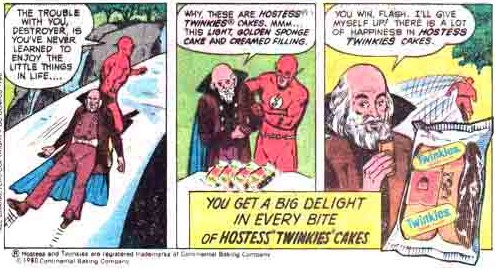If you read DC or Marvel comics during the late 1970s or early 1980s, or if you’ve read back issues from that era, chances are that you’ve seen the super-hero ads for Hostess cupcakes, Twinkies, etc. These were done as 1-page stories in which a low-rent villain would appear as a menace. Then a super-hero would arrive, and somehow use snack cakes to defeat the villain.
Yep.
There were at least four ads featuring the Flash:
- The Flash Meets the Bureauc-rat (Flash distracts the villain with fruit pies. And he’s a disgruntled city traffic planner with a “red tape gun.”)
- The Stony-Eyed Medusa (Ditto. Except for that city planner thing.)
- A Flash in the Dam (Flash reforms a depressed villain, The Destroyer, by introducing him to Twinkies.)
- Marathon Madman (Flash distracts “Dr. Sorcery,” a bargain basement substitute for Dr. Alchemy, with cupcakes.)
These are all scanned and hosted by Seanbaby, who has a full set of these Hostess ads. (Watch out for NSFW language in the commentary.)
You know, now that I think about it, the subtext of the Flash helping The Destroyer fight off his depression by eating junk food is disturbingly reminiscent of the Golden Age Flash providing “happiness pills” to the Worry Wart.
Sadly, the Destroyer didn’t share the Flash’s hyper-accelerated metabolism.
(Inspired by a recent post at Mike’s Progressive Ruin.)



